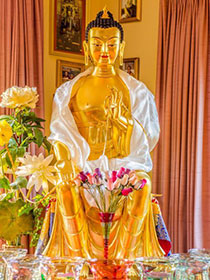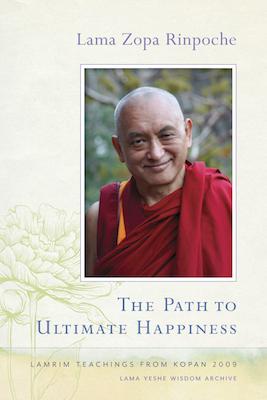- Home
- FPMT Homepage
Foundation for the Preservation of the Mahayana Tradition
The FPMT is an organization devoted to preserving and spreading Mahayana Buddhism worldwide by creating opportunities to listen, reflect, meditate, practice and actualize the unmistaken teachings of the Buddha and based on that experience spreading the Dharma to sentient beings. We provide integrated education through which people’s minds and hearts can be transformed into their highest potential for the benefit of others, inspired by an attitude of universal responsibility and service. We are committed to creating harmonious environments and helping all beings develop their full potential of infinite wisdom and compassion. Our organization is based on the Buddhist tradition of Lama Tsongkhapa of Tibet as taught to us by our founders Lama Thubten Yeshe and Lama Thubten Zopa Rinpoche.
- Willkommen
Die Stiftung zur Erhaltung der Mahayana Tradition (FPMT) ist eine Organisation, die sich weltweit für die Erhaltung und Verbreitung des Mahayana-Buddhismus einsetzt, indem sie Möglichkeiten schafft, den makellosen Lehren des Buddha zuzuhören, über sie zur reflektieren und zu meditieren und auf der Grundlage dieser Erfahrung das Dharma unter den Lebewesen zu verbreiten.
Wir bieten integrierte Schulungswege an, durch denen der Geist und das Herz der Menschen in ihr höchstes Potential verwandelt werden zum Wohl der anderen – inspiriert durch eine Haltung der universellen Verantwortung und dem Wunsch zu dienen. Wir haben uns verpflichtet, harmonische Umgebungen zu schaffen und allen Wesen zu helfen, ihr volles Potenzial unendlicher Weisheit und grenzenlosen Mitgefühls zu verwirklichen.
Unsere Organisation basiert auf der buddhistischen Tradition von Lama Tsongkhapa von Tibet, so wie sie uns von unseren Gründern Lama Thubten Yeshe und Lama Thubten Zopa Rinpoche gelehrt wird.
- Bienvenidos
La Fundación para la preservación de la tradición Mahayana (FPMT) es una organización que se dedica a preservar y difundir el budismo Mahayana en todo el mundo, creando oportunidades para escuchar, reflexionar, meditar, practicar y actualizar las enseñanzas inconfundibles de Buda y en base a esa experiencia difundir el Dharma a los seres.
Proporcionamos una educación integrada a través de la cual las mentes y los corazones de las personas se pueden transformar en su mayor potencial para el beneficio de los demás, inspirados por una actitud de responsabilidad y servicio universales. Estamos comprometidos a crear ambientes armoniosos y ayudar a todos los seres a desarrollar todo su potencial de infinita sabiduría y compasión.
Nuestra organización se basa en la tradición budista de Lama Tsongkhapa del Tíbet como nos lo enseñaron nuestros fundadores Lama Thubten Yeshe y Lama Zopa Rinpoche.
A continuación puede ver una lista de los centros y sus páginas web en su lengua preferida.
- Bienvenue
L’organisation de la FPMT a pour vocation la préservation et la diffusion du bouddhisme du mahayana dans le monde entier. Elle offre l’opportunité d’écouter, de réfléchir, de méditer, de pratiquer et de réaliser les enseignements excellents du Bouddha, pour ensuite transmettre le Dharma à tous les êtres. Nous proposons une formation intégrée grâce à laquelle le cœur et l’esprit de chacun peuvent accomplir leur potentiel le plus élevé pour le bien d’autrui, inspirés par le sens du service et une responsabilité universelle. Nous nous engageons à créer un environnement harmonieux et à aider tous les êtres à épanouir leur potentiel illimité de compassion et de sagesse. Notre organisation s’appuie sur la tradition guéloukpa de Lama Tsongkhapa du Tibet, telle qu’elle a été enseignée par nos fondateurs Lama Thoubtèn Yéshé et Lama Zopa Rinpoché.
Visitez le site de notre Editions Mahayana pour les traductions, conseils et nouvelles du Bureau international en français.
Voici une liste de centres et de leurs sites dans votre langue préférée
- Benvenuto
L’FPMT è un organizzazione il cui scopo è preservare e diffondere il Buddhismo Mahayana nel mondo, creando occasioni di ascolto, riflessione, meditazione e pratica dei perfetti insegnamenti del Buddha, al fine di attualizzare e diffondere il Dharma fra tutti gli esseri senzienti.
Offriamo un’educazione integrata, che può trasformare la mente e i cuori delle persone nel loro massimo potenziale, per il beneficio di tutti gli esseri, ispirati da un’attitudine di responsabilità universale e di servizio.
Il nostro obiettivo è quello di creare contesti armoniosi e aiutare tutti gli esseri a sviluppare in modo completo le proprie potenzialità di infinita saggezza e compassione.
La nostra organizzazione si basa sulla tradizione buddhista di Lama Tsongkhapa del Tibet, così come ci è stata insegnata dai nostri fondatori Lama Thubten Yeshe e Lama Zopa Rinpoche.
Di seguito potete trovare un elenco dei centri e dei loro siti nella lingua da voi prescelta.
- 欢迎 / 歡迎
简体中文
“护持大乘法脉基金会”( 英文简称:FPMT。全名:Foundation for the Preservation of the Mahayana Tradition) 是一个致力于护持和弘扬大乘佛法的国际佛教组织。我们提供听闻,思维,禅修,修行和实证佛陀无误教法的机会,以便让一切众生都能够享受佛法的指引和滋润。
我们全力创造和谐融洽的环境, 为人们提供解行并重的完整佛法教育,以便启发内在的环宇悲心及责任心,并开发内心所蕴藏的巨大潜能 — 无限的智慧与悲心 — 以便利益和服务一切有情。
FPMT的创办人是图腾耶喜喇嘛和喇嘛梭巴仁波切。我们所修习的是由两位上师所教导的,西藏喀巴大师的佛法传承。
繁體中文
護持大乘法脈基金會”( 英文簡稱:FPMT。全名:Found
ation for the Preservation of the Mahayana Tradition ) 是一個致力於護持和弘揚大乘佛法的國際佛教組織。我們提供聽聞, 思維,禪修,修行和實證佛陀無誤教法的機會,以便讓一切眾生都能 夠享受佛法的指引和滋潤。 我們全力創造和諧融洽的環境,
為人們提供解行並重的完整佛法教育,以便啟發內在的環宇悲心及責 任心,並開發內心所蘊藏的巨大潛能 — 無限的智慧與悲心 – – 以便利益和服務一切有情。 FPMT的創辦人是圖騰耶喜喇嘛和喇嘛梭巴仁波切。
我們所修習的是由兩位上師所教導的,西藏喀巴大師的佛法傳承。 察看道场信息:
- FPMT Homepage
- News/Media
-
- Study & Practice
-
-
- About FPMT Education Services
- Latest News
- Programs
- New to Buddhism?
- Buddhist Mind Science: Activating Your Potential
- Heart Advice for Death and Dying
- Discovering Buddhism
- Living in the Path
- Exploring Buddhism
- FPMT Basic Program
- FPMT Masters Program
- FPMT In-Depth Meditation Training
- Maitripa College
- Lotsawa Rinchen Zangpo Translator Program
- Universal Education for Compassion & Wisdom
- Online Learning Center
-
- Prayers & Practice Materials
- Overview of Prayers & Practices
- Full Catalogue of Prayers & Practice Materials
- Explore Popular Topics
- Benefiting Animals
- Chenrezig Resources
- Death & Dying Resources
- Lama Chopa (Guru Puja)
- Lama Zopa Rinpoche: Compendium of Precious Instructions
- Lama Zopa Rinpoche: Life Practice Advice
- Lama Zopa Rinpoche Practice Series
- Lamrim Resources
- Mantras
- Prayer Book Updates
- Purification Practices
- Sutras
- Thought Transformation (Lojong)
- Audio Materials
- Dharma Dates - Tibetan Calendar
- Translation Services
- Publishing Services
- Ways to Offer Support
- Prayers & Practice Materials
-
- Teachings and Advice
- Find Teachings and Advice
- Lama Zopa Rinpoche Advice Page
- Lama Zopa Rinpoche: Compendium of Precious Instructions
- Lama Zopa Rinpoche Video Teachings
- ༧སྐྱབས་རྗེ་བཟོད་པ་རིན་པོ་ཆེ་མཆོག་ནས་སྩལ་བའི་བཀའ་སློབ་བརྙན་འཕྲིན།
- Podcasts
- Lama Yeshe Wisdom Archive
- Buddhism FAQ
- Dharma for Young People
- Resources on Holy Objects
- Teachings and Advice
-
-
*If a menu item has a submenu clicking once will expand the menu clicking twice will open the page.
-
-
- Centers
-
- Teachers
-
- Projects
-
-
-
-
*If a menu item has a submenu clicking once will expand the menu clicking twice will open the page.
-
-
- FPMT
-
-
-
-
-
No anger inside means no enemy outside.
Lama Zopa Rinpoche
-
-
-
- Shop
-
-
-
The Foundation Store is FPMT’s online shop and features a vast selection of Buddhist study and practice materials written or recommended by our lineage gurus. These items include homestudy programs, prayers and practices in PDF or eBook format, materials for children, and other resources to support practitioners.
Items displayed in the shop are made available for Dharma practice and educational purposes, and never for the purpose of profiting from their sale. Please read FPMT Foundation Store Policy Regarding Dharma Items for more information.
-
-
Lama Zopa Rinpoche News and Advice
2
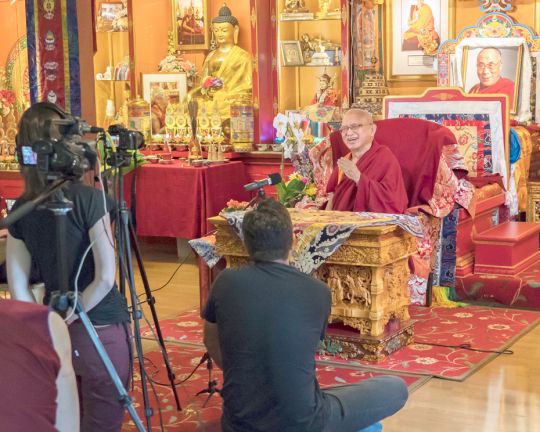
Lama Zopa Rinpoche being interview by Wisdom Publication’s Daniel Aitken for a Wisdom Podcast, Kurukulla Center, Massachusetts, US, August 2018. Photo by Ven. Lobsang Sherab.
Wisdom Publications recently featured Lama Zopa Rinpoche in its Wisdom Podcast. Daniel Aitken, director of Wisdom Publications, spoke with Rinpoche for over an hour, during Rinpoche’s visit to Kurukulla Center in Boston, US, in August 2018.
In the far-ranging interview, Rinpoche speaks on many topics, including stories about his early days as a young monk, how he became a Gelugpa, and how he ended up at Buxa in West Bengal, India, where he met Lama Yeshe. Rinpoche also offers a succinct teaching on emptiness and everyday practice advice.
“Now there is much more understanding of Buddhism, what Buddhism is, really,” Rinpoche said when asked about how Dharma practice has developed in the West over the past fifty years.
“That has happened and so much is happening, but overall the most important, the most important, you see, the essence of Buddhadharma is compassion. Compassion that not only wishes sentient beings, who are obscured and suffering, to be free from suffering, not only that, but you want to free, you want to help the sentient beings to be free from sufferings and the cause of sufferings.
“Overall, I think, as regards the FPMT students, overall as the years went through, I checked, so it looks like more compassion has developed among the people. More compassion, more understanding and more compassion, has developed. This is what I see.”
This Wisdom Podcast of Lama Zopa Rinpoche is available as audio or video, both with a transcript.
Watch the Wisdom Podcast interview on YouTube:
https://youtu.be/ZFPvDq5kyfQ
There are dozens of Wisdom Podcasts available to listen to. Recent guests include Geshe Thubten Jinpa, Geshe Tashi Tsering, and His Holiness the Sakya Trichen Ngawang Kunga, among many other accomplished teachers, scholars, and practitioners of Buddhism.
Find the Wisdom Podcast of Lama Zopa Rinpoche online:
https://learn.wisdompubs.org/podcast/lama-zopa/
Watch Lama Zopa Rinpoche teach LIVE from Spain, Germany, and Switzerland, October 19-November 18! For links to live video streams:
https://fpmt.org/media/streaming/lama-zopa-rinpoche-live/
Lama Zopa Rinpoche is the spiritual director of the Foundation for the Preservation of Mahayana Tradition (FPMT), a Tibetan Buddhist organization dedicated to the transmission of the Mahayana Buddhist tradition and values worldwide through teaching, meditation and community service.
29
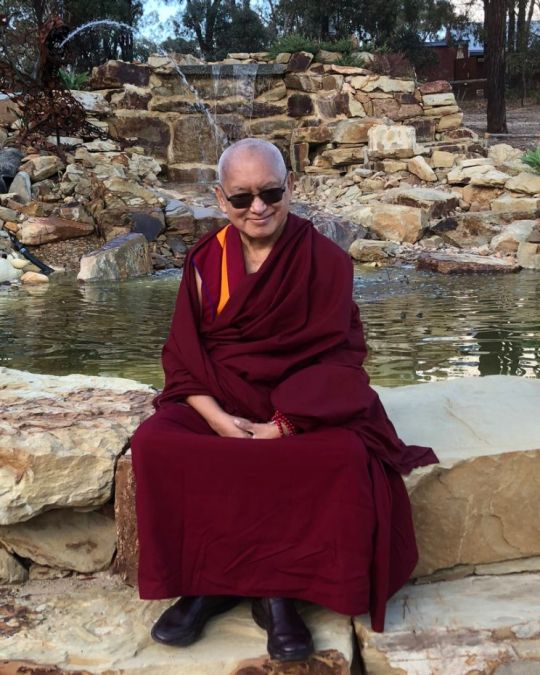
Lama Zopa Rinpoche in the Peace Park at the Great Stupa of Universal Compassion, Australia, May 2018. Photo by Ven. Roger Kunsang.
During the 2018 retreat in Australia, Lama Zopa Rinpoche explained the various results of positive actions, captured in this excerpt and video clip:
What Guru Shakyamuni Buddha sees, all the rest of the buddhas see similarly. They don’t find mistakes. No buddha finds mistakes in the way Guru Shakyamuni Buddha’s omniscient mind sees reincarnation and karma, all the past, present, and future things—karma and its result. From virtuous action, karma, the result of happiness arises; from nonvirtuous action the result of suffering arises.
As I explained before, by practicing morality [in the past]—abstaining from killing—then in this life you have received the body of a happy transmigratory being. You have received, this time, a human body. That is the ultimate reason. The real proof, reason, is that.
Then in a past life you made charity. You practiced Dharma and made charity, not being miserly, making charity to other sentient beings of materials. Your merit—you made charity to others, so in this life you received wealth.
In a past life you practiced patience, so in this lifetime you have a beautiful body. And if you want to receive or to be born a human being with a beautiful body then you must practice patience in this life. Not get angry and practice patience, you have to know that.
Watch Lama Zopa Rinpoche’s teaching “How to Achieve a Beautiful Human Body”:
https://youtu.be/bxDHB7qLP2o
Like Michael Jackson, he went so many times to make-up shops, to fix his nose, to fix this, to fix that. So many times he went to make-up shops. Not make-up, what do you call it? Operation. So many times Michael Jackson went. He died. I don’t know where he is. Maybe he is still dancing in a different body, maybe in an animal body he is dancing. I can’t say. Or maybe as a deva with a goddess he is dancing. I’m not sure.
So many people while they are young, they change many times. Then as they get older, their skin hanging, then they do an operation. So many times. You don’t need that if you practice patience instead of getting angry. If instead of getting angry you practice patience.
Even if one time you practice patience with somebody who makes you angry, for five hundred lifetimes you will have a beautiful body. It is like that if you practice patience one time with somebody, with insects, ants, with a mouse, with your parents, with your children, with your husband or wife. You practice patience then [you receive] a beautiful body for five hundred lifetimes.
If you practice patience one time, then for thousands, millions, bah, bah, bah.… You don’t need to go to make-up shops. You don’t need to build so many debts, debts, money, money, debts. If you don’t get enough money from your job, you get debts. You borrow money so many times, then you fail. You can go bankrupt. Then you hide. You go to Mount Everest. You go behind Mount Everest, in Tibet—I’m joking—or you go to Mount Kailash to hide.
Colophon: Excerpted from Lama Zopa Rinpoche’s teachings at the Great Stupa of Universal Compassion, Bendigo, Victoria, Australia, April 1, 2018. Simultaneously transcribed by Ven. Joan Nicell. Lightly edited by Laura Miller, October 2018.
Watch Lama Zopa Rinpoche teach LIVE from Spain, Germany, and Switzerland, October 19-November 18! For links to live video streams:
https://fpmt.org/media/streaming/lama-zopa-rinpoche-live/
Find complete videos of Lama Zopa Rinpoche’s recent teachings:
https://fpmt.org/media/streaming/teachings-of-lama-zopa-rinpoche/
Lama Zopa Rinpoche is the spiritual director of the Foundation for the Preservation of Mahayana Tradition (FPMT), a Tibetan Buddhist organization dedicated to the transmission of the Mahayana Buddhist tradition and values worldwide through teaching, meditation and community service.
26
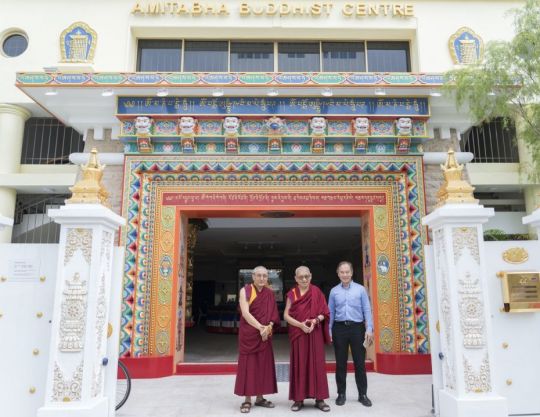
Khen Rinpoche Geshe Thubten Chonyi, Lama Zopa Rinpoche, and Tan Hup Cheng in front of Amitabha Buddhist Center’s new entrance painted by Peter Griffin, Singapore, September 2018. Photo by Ven. Lobsang Sherab.
Lama Zopa Rinpoche arrived in Singapore on September 10, 2018, where he was greeted by a large group of students at the airport. Rinpoche spent the following three weeks leading activities at FPMT center Amitabha Buddhist Centre. The program ended on September 29 with a long life puja for Rinpoche. Shila Gephel, a long-time student of Lama Zopa Rinpoche, shares the story.
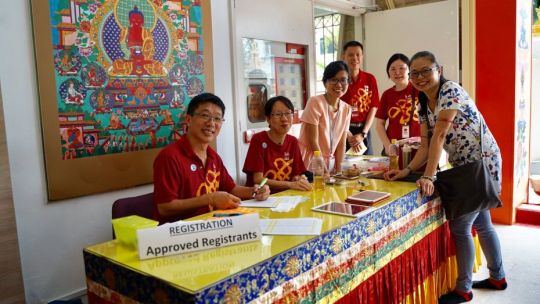
Kelvin Lee, Doris Lim , Toh Su Fen, Tan Wee Meng, Sandra Chen, and Ong Cheng Cheng at the Amitabha Buddhist Centre registration table, Singapore, September 2018. Photo by Tan Seow Kheng.
Lama Zopa Rinpoche’s presence at Amitabha Buddhist Centre galvanized both old and new students, many who had come from different parts of the world, including Mongolia, Spain, Italy, Britain, Taiwan, and neighboring Malaysia.
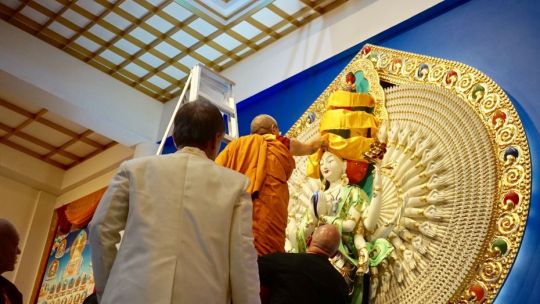
Lama Zopa Rinpoche and Tan Hup Cheng watching Khen Rinpoche Geshe Thubten Chonyi offer the golden crown to the Chenrezig statue at Amitabha Buddhist Centre, Singapore, September 2018. Photo by Tan Seow Kheng.
The program started on September 13 with Rinpoche offering the newly finished golden crown to the Chenrezig statue in the main gompa and taking time to explain about the incredible benefits of offering to holy objects. “It is exactly the same as having made offerings to the actual Buddha or Chenrezig, and that means also exactly the same as offering to His Holiness the Dalai Lama.”
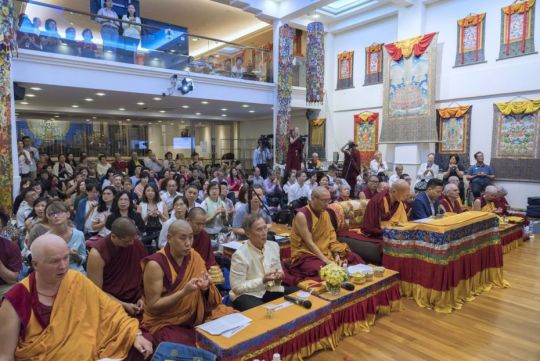
Lama Zopa Rinpoche making offerings to Chenrezig during the golden crown offering ceremony at Amitabha Buddhist Centre, Singapore, September 2018. Photo by Ven. Lobsang Sherab.
Watch the short video, A Thousand Hands – The Wish Fulfilled, by Ven. Tenzin Tsultrim:
https://youtu.be/98Z0Px5aL1o
Rinpoche continued in the days after to give mind-training teachings, an Amitabha Obtaining the Pure Land initiation, and extensive Lama Chopa commentary. Rinpoche said that so many holy beings actualized the Lama Chopa and that this teaching has not degenerated; it is still warm with blessing.
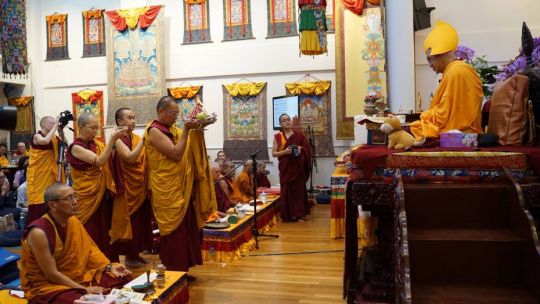
Ven. Tenzin Tsultrim, Ven. Gyalten Rabten, and Ven. Tenzin Drachom making the offering to Lama Zopa Rinpoche during Lama Chopa at Amitabha Buddhist Centre, Singapore, September 2018. Photo by Tan Seow Kheng.
Rinpoche also reminded us that “if one doesn’t get to practice Dharma, learn Dharma, actualize the true path, wisdom directly realizing emptiness, then we will cycle again endlessly in samsara, suffering. The most important answer is to want to benefit others, that is the real answer.”

Wong Lai Kuen and Jangchup, named by Lama Zopa Rinpoche, during the tsog puja at Amitabha Buddhist Centre, Singapore, September 2018. Photo by Tan Seow Kheng.
To the people attending the South East Asian Regional Meeting, Rinpoche spoke about the Masters Program and Basic Program that are being taught in the centers and the importance of doing retreat after study. “Even if one is able to actualize one lamrim realization, it is so worthwhile.”
Rinpoche then said how his wish now is for FPMT students to develop lamrim experiences more and more, and that the most important thing for FPMT’s success is to have good samaya with His Holiness the Dalai Lama, Lama Yeshe, and Rinpoche.
A long life puja was offered to Rinpoche on the last day of the program with Rinpoche reminding us again about “how important it is to practice the bodhisattva attitude so all your actions are dedicated for sentient beings.”
In these three blessed weeks, the center was filled to capacity as humans and pets alike imbibed the unending wisdom of the holy guru and rejoiced at the collection of dreamlike merits.
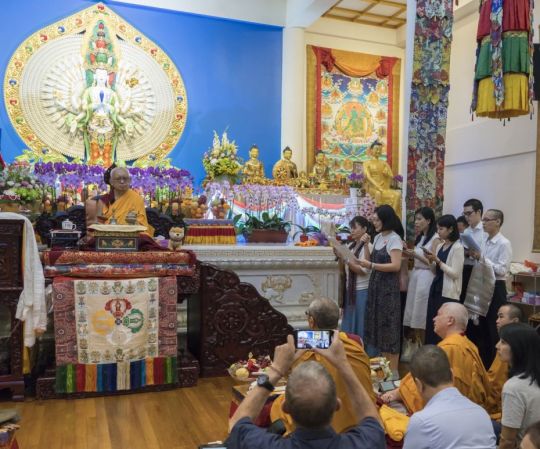
The Amitabha Buddhist Centre choir singing Lama Zopa Rinpoche’s long life prayer to Rinpoche, Singapore, September 2018. Photo by Ven. Lobsang Sherab.
Watch a short video created by Alaric, Heather, and Qiping that captures the highlights of Rinpoche’s visit:
https://youtu.be/JP7-v5PxcKk
To learn more about Amitabha Buddhist Centre, visit their website:
http://www.fpmtabc.org/
View the photo album of Rinpoche’s visit to Singapore:
https://fpmt.org/teachers/zopa/gallery/singapore-september-2018/
Watch Lama Zopa Rinpoche teach LIVE from Spain, Germany, and Switzerland, October 19-November 18! For links to live video streams:
https://fpmt.org/media/streaming/lama-zopa-rinpoche-live/
Find complete videos of Lama Zopa Rinpoche’s recent teachings, including from Singapore:
https://fpmt.org/media/streaming/teachings-of-lama-zopa-rinpoche/
FPMT.org and Mandala Publications brings you news of Lama Zopa Rinpoche and of activities, teachings, and events from over 160 FPMT centers, projects, and services around the globe. If you like what you read, consider becoming a Friend of FPMT, which supports our work.
- Tagged: amitabha buddhist centre, khen rinpoche geshe chonyi, lama zopa rinpoche, shila gephel, tan seow kheng, ven. tenzin tsultrim
22
The Wisdom Realizing Emptiness
Lama Yeshe Wisdom Archive has just published The Path to Ultimate Happiness, an ebook of teachings given by Lama Zopa Rinpoche during the 42nd Kopan lamrim course. In this book, Rinpoche discusses our potential to bring benefit and happiness, including full enlightenment, to all sentient beings. Here’s a short excerpt:
By realizing the most subtle level of emptiness we are able to cut the very root of samsara, ignorance. There are many types of ignorance, but this is particularly the ignorance holding the I, the self, as something real in the sense of existing from its own side, not merely labeled by mind. The I that exists from its own side is something that is not there at all; it totally doesn’t exist. But this ignorance holds onto such a false I, not the I that does exist.
There is an I that exists, but it is empty. While it exists it’s empty, unifying emptiness and dependent arising, unifying ultimate truth and conventional truth, the truth for the ultimate wisdom and the truth for the all-obscuring mind. There are these two truths, ultimate truth and conventional truth, and emptiness and dependent arising unifies the two. That is how the I exists.
That is the view of the Prasangika school, the wisdom realizing emptiness that is explained by that school, by recognizing the subtle object to be refuted, the very subtle hallucination. This does not happen by realizing the emptiness explained by the previous schools, only by the Prasangika’s explanation. There is only one emptiness and only by realizing that can we cut the root of samsara, ignorance.
Excerpted from The Path to Ultimate Happiness, teachings given by Lama Zopa Rinpoche during the 42nd Kopan lamrim course in 2009 at Kopan Monastery, Nepal, lightly edited by Gordon McDougall and Sandra Smith.
You can order The Path to Ultimate Happiness from the Lama Yeshe Wisdom Archive or the FPMT Foundation Store:
https://www.lamayeshe.com/shop/path-ultimate-happiness-ebook
https://shop.fpmt.org/-The-Path-to-Ultimate-Happiness-eBook-PDF-_p_3134.html
Watch Lama Zopa Rinpoche teach LIVE from Spain, Germany, and Switzerland, October 19-November 18! For links to live video streams:
https://fpmt.org/media/streaming/lama-zopa-rinpoche-live/
Lama Zopa Rinpoche is the spiritual director of the Foundation for the Preservation of Mahayana Tradition (FPMT), a Tibetan Buddhist organization dedicated to the transmission of the Mahayana Buddhist tradition and values worldwide through teaching, meditation, and community service.
19
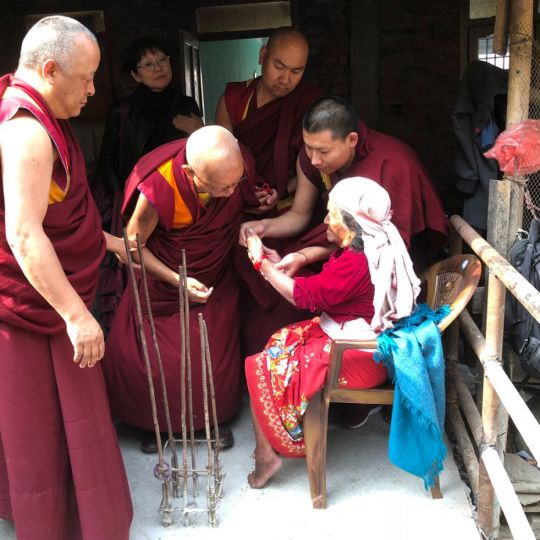
Lama Zopa Rinpoche blessing a sick woman in Maratika, Nepal, February 2018. Photo by Ven. Roger Kunsang.
Lama Zopa Rinpoche first taught at the month-long lamrim meditation course at Kopan Monastery in 1971. Rinpoche continues to offer teachings at the course most years. During a teaching at the 2017 Kopan Course, Rinpoche spoke about the great Drukpa Kagyu practitioner Gyalwa Gotsangpa (1189–1258):
Gotsangpa was unbelievable. I read the life story. He almost passed away by so many lice attacking him. He purposefully made charity of his body to the lice. Two times or three times he almost passed away.
He bore most unbelievable, unbelievable, unbelievable hardships to practice Dharma, purposefully. He was not just somebody who was very poor; he was poor, but not like that. He purposefully chose to bear hardships.
This lama, this great yogi, he had no interest in monasteries, organizations. His whole life was without monasteries, organizations. Gotsangpa. So comparing his Dharma practice to our Dharma practice, which is just between our lips, but his is wow, wow, wow, unbelievable hardships!
His advice is when you have sickness, when you experience cancer, relationship problems, or anything, pray: “May all sentient beings be free from sicknesses, spirit harm, negative karma, defilements.” Negative karma and defilements are collected from beginningless rebirths. “May all sentient beings be free from disease, spirit harm, negative karma, and defilements.”
“By my experiencing this sickness,” so every sickness, even relationship problems, or whatever, do according to that. So cancer, whatever it is: “By my experiencing this sickness or this problem, then may all sentient beings be free from sicknesses, spirit harm, negative karma, and defilements, and quickly be free and achieve enlightenment.”
You recite that like OM MANI PADME HUM, a mala. Like reciting a mantra, recite it like that. Meditate like that and recite like that. That is unbelievably good.
Even while you are walking, sitting, whatever, recite like that. So you collect merits more than the sky. You collect so many merits, more than the sky, when you do this, and it becomes the greatest purification, purifying the defilements and negative karma that you collected from beginningless rebirths. Then it becomes a quick path to enlightenment for you.
In other words, you use your problem; you use it for other sentient beings, numberless sentient beings, to achieve enlightenment. To free them from all the suffering and to achieve enlightenment, you use yourself, including your problem.
Like that, it is amazing. If you do like that, like reciting a mantra, if you do like that, then the cancer can be cured. Even if it is cancer, even if it is a disease for which there is no medicine, it can be cured.
Watch the teaching by Lama Zopa Rinpoche from which this excerpt is taken:
https://youtu.be/59YtMWKaxZ8
Colophon: Excerpted from Lama Zopa Rinpoche’s teachings at Kopan Monastery in Nepal, December 8, 2017. Simultaneously transcribed by Ven. Joan Nicell. Lightly edited by Laura Miller, October 2018.
Find out more about the courses offered at Kopan Monastery:
http://kopanmonastery.com/courses-retreats/courses
Find complete videos of Lama Zopa Rinpoche’s recent teachings:
https://fpmt.org/media/streaming/teachings-of-lama-zopa-rinpoche/
Lama Zopa Rinpoche is the spiritual director of the Foundation for the Preservation of Mahayana Tradition (FPMT), a Tibetan Buddhist organization dedicated to the transmission of the Mahayana Buddhist tradition and values worldwide through teaching, meditation and community service.
- Tagged: essential extract, hardships, kopan course, lama zopa rinpoche, practice, video
12
Practicing Kindness
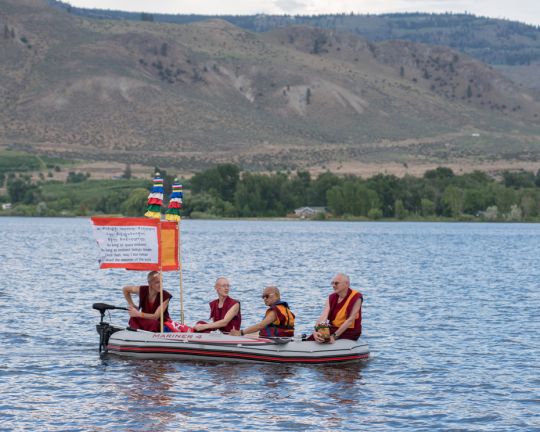
Lama Zopa Rinpoche blessing all the beings in a lake in Washington State, US, June 2018. Photo by Ven. Lobsang Sherab.
Lama Yeshe Wisdom Archive has just published The Path to Ultimate Happiness, a new ebook of teachings given by Lama Zopa Rinpoche during the 42nd Kopan lamrim course.
In this book, Rinpoche discusses our potential to bring benefit and happiness, including full enlightenment, to all sentient beings. Rinpoche explains the lamrim, the stages of the path to enlightenment, teaches extensively on emptiness and the good heart, and gives commentaries on sur practice, the Offering Cloud Mantra, and other prayers and practices.
The Path to Ultimate Happiness conveys the spontaneous and intimate quality of Rinpoche’s teaching style and includes many anecdotes from his own experiences. Here’s a short excerpt:
The teachings about karma are very, very important. If you remember this in your daily life you will become very careful, not only avoiding negativities, not harming others, but also being kind, generous and gentle to them. You are able to practice this because you see its importance. You are able to abandon the negative karmas that cause you to receive harm from sentient beings for hundreds or thousands of lifetimes.
Conversely, when you do one act of kindness for a sentient being, you will receive help from that sentient being for hundreds and thousands of lifetimes. From your one act of kindness you receive the benefit from that sentient being for hundreds, thousands of lifetimes. Therefore, if you want to be happy, if you don’t want to receive harm from others, you need to practice the good heart, you need to be kind to others, not only to your friends but even to your enemies and strangers. Practicing kindness, you receive the result—happiness, enjoyment—from that sentient being for many hundreds, thousands of lifetimes.
The conclusion is that every day of your life, day and night, practice kindness to others, thus causing others to have happiness. That is essential; it’s the cause of your own happiness, not only in this life but in thousands of future lifetimes.
If you want your wishes to succeed all the time, you should make others’ wishes succeed. Causing others’ wishes to succeed is the cause of success of your wishes every day of your life. As much as you are able to do that, the result will be that in this life and all the future lives, all the time your wishes will succeed. Without any effort, without any worry or fear, whatever wish you have will just happen, exactly like that, including achieving enlightenment. Practicing kindness, as much as you can, you should fulfill the wishes of others. From one act of kindness your wishes are fulfilled for hundreds of thousands of lifetimes.
As His Holiness the Dalai Lama always says, if you want to live your life with a selfish attitude it’s better to live it by being intelligently selfish. By helping others, being kind to others, the result is that you will get happiness. From one act of fulfilling one wish of a sentient being, your wishes will succeed for hundreds of lifetimes, thousands of lifetimes. This is being intelligently selfish, thinking of how to get all your wishes fulfilled. This is correct but the main reason for helping others is still for your own happiness.
For bodhisattvas there is never a thought for their own happiness. It doesn’t arise even for a second. There is always the thought of cherishing others, of seeking happiness for the other sentient beings: the numberless hell beings, the numberless hungry ghosts, the numberless animals, the numberless human beings and the numberless gods and demigods. Only practicing kindness, fulfilling others’ wishes for happiness, thinking of others’ happiness, the bodhisattvas’ attitude is very pure. This is what we should all try to practice in our daily life.
Excerpted from The Path to Ultimate Happiness, teachings given by Lama Zopa Rinpoche during the 42nd Kopan lamrim course in 2009 at Kopan Monastery, Nepal, lightly edited by Gordon McDougall and Sandra Smith.
To order the new ebook The Path to Ultimate Happiness, visit:
https://www.lamayeshe.com/shop/path-ultimate-happiness-ebook
An ebook series that presents teachings from the 24th Kopan course in 1991 is also available from Lama Yeshe Wisdom Archive. For more:
https://www.lamayeshe.com/article/kopan-course-no-24-1991-ebook-series
Lama Zopa Rinpoche is the spiritual director of the Foundation for the Preservation of Mahayana Tradition (FPMT), a Tibetan Buddhist organization dedicated to the transmission of the Mahayana Buddhist tradition and values worldwide through teaching, meditation, and community service.
- Tagged: book excerpts, karma, kopan course, lama yeshe wisdom archive, lama zopa rinpoche, loving kindness
8

Lama Zopa Rinpoche during Lama Chopa at Kopan Monastery on Lama Tsongkhapa Day, Nepal, December 2017. Photo by Ven. Lobsang Sherab.
Every year the month-long lamrim meditation course at Kopan Monastery in Nepal draws more than two hundred students from around the world. And every year the November Course, as it’s called, fills up quickly. Many students starting planning to attend the transformative program months, if not years, in advance.
Lama Zopa Rinpoche first taught the month-long lamrim course in 1971. Rinpoche continues to offer teachings at the course almost every year. Last year Rinpoche spoke to students about the significance of attending the course and how it helps one deal with individual and societal problems. The following is a short excerpt from that teaching:
Coming to Kopan Monastery—attending one of the meditation courses—is to pacify the negative mind that brings all the problems, global problems. Coming here is to pacify that. You understand the point? It is most important.
So you are coming here to learn meditation. What you are learning, that is the most important thing in the world, the most important thing in your life.
That helps not only this life, it helps not only the next life, it helps hundreds and thousands, millions, it goes on, the benefit goes on and on. It goes on to enlightenment.
Ultimately it goes on to enlightenment. Your coming here to do meditation—listening and meditating—all this goes up to enlightenment for numberless sentient beings.
You achieve enlightenment for numberless sentient beings—for every ant you see in the road, in the gompa, every bird, every dog and cat, people, every sentient being—to benefit everyone, to free them from the oceans of suffering of samsara and bring them to buddhahood, peerless happiness, buddhahood.
So your coming here, learning lamrim meditation, meditating to actualize, is so the mind, the child mind, is transformed into a mind that cherishes others, like the Buddha did. …
Watch the teaching by Lama Zopa Rinpoche from which this excerpt is taken:
https://youtu.be/r2fmyis25pw
Colophon: Excerpted from Lama Zopa Rinpoche’s teachings at Kopan Monastery in Nepal, December 8, 2017. Simultaneously transcribed by Ven. Joan Nicell. Lightly edited by Laura Miller, October 2018.
Find out more about the November Course and other opportunities to learn and meditate at Kopan Monastery:
http://kopanmonastery.com/courses-retreats/courses
Find complete videos of Lama Zopa Rinpoche’s recent teachings:
https://fpmt.org/media/streaming/teachings-of-lama-zopa-rinpoche/
Lama Zopa Rinpoche is the spiritual director of the Foundation for the Preservation of Mahayana Tradition (FPMT), a Tibetan Buddhist organization dedicated to the transmission of the Mahayana Buddhist tradition and values worldwide through teaching, meditation and community service.
- Tagged: essential extract, kopan course, kopan monastery, lama zopa rinpoche, lamrim, practice, video
5
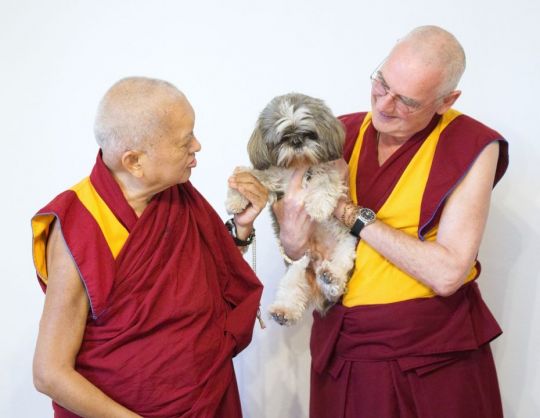
Lama Zopa Rinpoche and Ven. Roger Kunsang with FPMT Italy coordinator Lara Gatto’s dog, Istituto Lama Tzong Khapa, Pisa, Italy, November 2017. Photo by Ven. Lobsang Sherab.
Lama Zopa Rinpoche gave the following advice to a student who had asked Rinpoche how to purify his dog’s negative karma.
Regarding purification for yourself and your dog, take strong refuge in the Buddha and think that the Buddha sends light to yourself and your dog, and to any other animals or beings you want to think about. Think nectar comes from the Buddha and purifies the negative karma, created from beginningless time, of yourself and the dog and other beings you are thinking about.
Then recite the refuge prayer. Keep reciting the refuge prayer while visualizing the Buddha sending nectar out of his compassion and loving kindness, like sunlight, to yourself and your dog. It’s like switching the light on in a dark room; it totally purifies the negative karma created since beginningless rebirths. You can keep the dog nearby when you do this so the dog can hear you reciting the refuge prayer. This leaves an imprint on the dog’s mind and plants the seed of enlightenment.
If there is no stupa near where you live, then maybe you can go to a center that has a stupa. If you are able to go there that would be very good, then you take your dog around the holy objects, the stupas. Go around the holy objects as many times as possible with the dog. This purifies the negative karma collected since beginningless rebirths, therefore go around as many holy objects as possible with the dog.
This advice, “How to Purify a Dog’s Karma,” is from “Lama Zopa Rinpoche’s Online Advice Book,” published in September 2018 on the Lama Yeshe Wisdom Archive website:
https://www.lamayeshe.com/advice/how-purify-dog%E2%80%99s-karma
https://fpmt.org/education/
Lama Zopa Rinpoche is the spiritual director of the Foundation for the Preservation of Mahayana Tradition (FPMT), a Tibetan Buddhist organization dedicated to the transmission of the Mahayana Buddhist tradition and values worldwide through teaching, meditation, and community service.
3
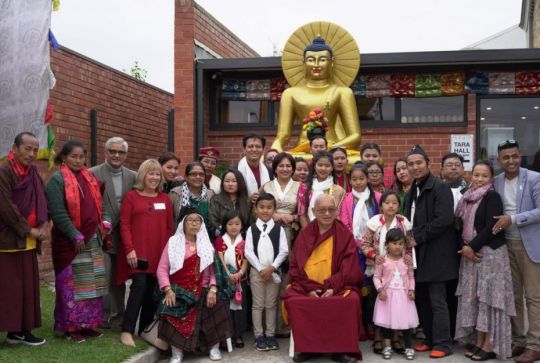
Association of Himalayan Buddhists of South Australia (AHIMBSA) and Lyndy Abram at Buddha House, South Australia, May 2018. Photo courtesy of Buddha House.
Lyndy Abram, center director of Buddha House, an FPMT center located in a suburb of Adelaide, South Australia, shares about the center’s friendship with the Himalayan Buddhist community of South Australia.
Last September we received a request from the Association of Himalayan Buddhists of South Australia (AHIMBSA) for a blessing from our then-resident teacher, Geshe Konchog Kyab. About forty people of all ages came to Buddha House for the visit. They were very excited to meet with a lama. I decided to follow up with the AHIMBSA representatives to see what we could do to help them.
It turned out there are 3,500 Himalayan refugees living in the northern suburbs of Adelaide. They have been coming here since 2008, and it is a growing community. They told us that they had lived most of their lives in refugee camps in Nepal and had previously been in Bhutan. They told stories of torture and having been in solitary confinement, chained, for years. Some of the people who directly experienced this were at the meeting. They told us they had not had access to any Buddhist teachings due to the circumstances of being a refugee.
The Board of Buddha House agreed we should partner with their community, offering teachings for the adults and the children, and whenever a visiting teacher comes to involve them in the visit.
Our friendship with them is growing. A large number of AHIMBSA members came to Buddha House in May 2018 for the opening of our new location, where they met Lama Zopa Rinpoche. Some of the children sang a national song as part of the ceremony.
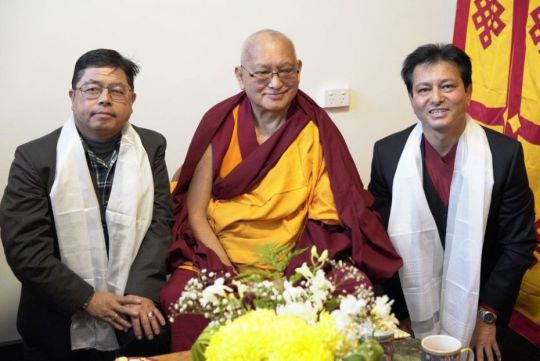
Bahadur Gurung, AHIMBSA chairman, and Jogen, translator, having afternoon tea with Lama Zopa Rinpoche, South Australia, May 2018. Photo courtesy of Buddha House.
Rinpoche had afternoon tea with Bahadur Gurung, AHIMBSA’s chairman, and Jogen, translator, and they shared their stories with him. Rinpoche said to them it is much better for you to practice Dharma here than it was in Nepal, because in the refugee camps you did not have access to Dharma teachings.
Buddha House wants to ensure we help AHIMBSA as much as possible. We are so fortunate to have the Dharma, as well as the freedom to practice, attend teachings, and spend time with the Dharma community. Meeting them and hearing their stories has helped us understand our good fortune.
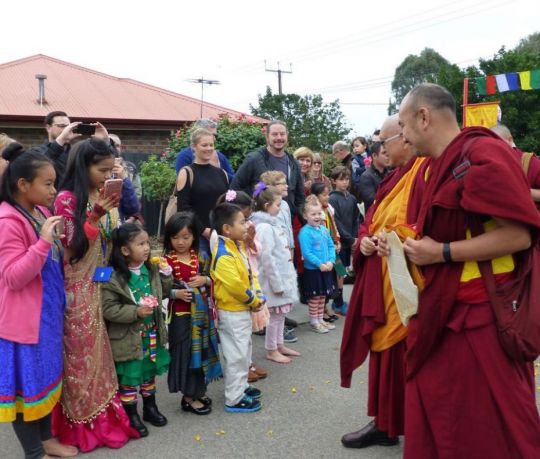
AHIMBSA youth and Buddha House Dharma Kids Club greet Lama Zopa Rinpoche at Buddha House, South Australia, May 2018. Photo courtesy of Buddha House.
They would particularly like help with the children, which we are able to do through providing a Dharma club. Ven. Dondrub and myself go to a hall AHIMBSA hires monthly. I run a Dharma club for kids class then Ven. Dondrub gives a Dharma talk to the adults. Since many community members do not speak English, they provide a Nepali translator for him.
AHIMBSA really wants help with their young adults. I asked Geshe Tenzin Zopa, who has met with them twice now for teachings and blessings, what they might do. He suggested doing activities teenagers want to do—outings, camps—and then introduce Dharma topics in a setting they feel comfortable in.
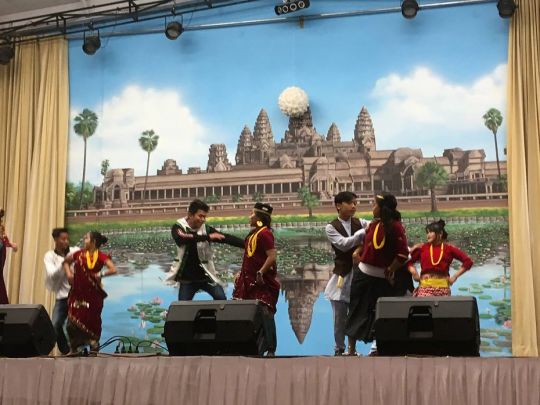
AHIMBSA youth performance at AHIMBSA’s second anniversary celebration, Cambodian Buddhist Hall of Salisbury, South Australia, July 2018. Photo courtesy of Buddha House.
In July 2018 AHIMBSA celebrated its second anniversary by throwing a celebration held at the Cambodian Buddhist Hall of Salisbury. They invited Buddha House representatives to a joyous day of entertainment, and to honor the lives of their elders. Three women in their nineties were given certificates of honor and were covered in blessing scarves and shawls by the local members of parliament.
They honored people from organizations who help their community which included myself, representing Buddha House. The children were given blessing strings and mantra cards which were a gift from Rinpoche.

Lyndy Abram with AHIMBSA youth at AHIMBSA’s second anniversary celebration, Cambodian Buddhist Hall of Salisbury, South Australia, July 2018. Photo by Janne Graham.
The young people performed cultural, Bollywood, and modern-style dances. There were also music performances, and a meal and chai were given to the more than 1,000 people in attendance. It was a wonderful day.
We are so fortunate to have met with this vibrant, happy community we can now call our friends.
For more information about Buddha House visit their website:
http://buddhahouse.org
FPMT.org and Mandala Publications brings you news of Lama Zopa Rinpoche and of activities, teachings, and events from over 160 FPMT centers, projects, and services around the globe. If you like what you read, consider becoming a Friend of FPMT, which supports our work.
1
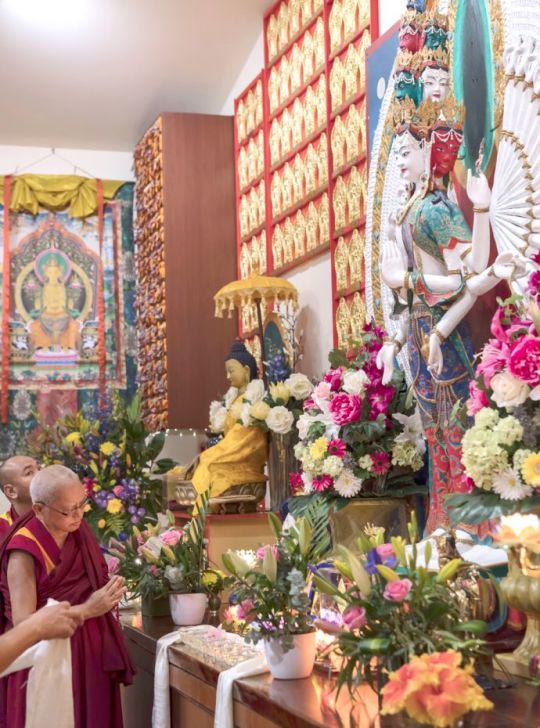
Lama Zopa Rinpoche in Chenrezig Institute gompa, Eudlo, Australia, June 2018. Photo by Ven. Lobsang Sherab.
During a teaching at Chenrezig Institute in June 2018, Lama Zopa Rinpoche discussed how we don’t know when our time of death will arrive.
So death can happen any time. You never know.
At Kopan when we were together—Lama Yeshe and Losang Nyima, Lama’s disciple from Tibet, the attendant from Buxa, and then Zina Rachevsky, the first Russian student—when we were together, I was thinking, “Who will die first?” I didn’t say anything, but I was thinking, “Who will die first?” I was thinking it as we were sitting around.
Even the Buddha wasn’t in the same aspect. He showed impermanence with the holy body.
Lama Yeshe passed away, a long time ago. Now you see only the bones, Lama’s relics. Losang Nyima is dead. Zina is dead. Lama Lhundrup—who was an excellent disciple of Lama Yeshe from Tibet, had excellent Dharma knowledge of philosophy, debate and all that, who was totally devoted to Lama, devoted to whatever Lama said, and had a stable mind, devotion—he passed away. Lama Pasang, who helped to build houses, bring food, and all that, also dead. So many already left the monastery.
Just from that you can understand. So at the moment we are in the process—I don’t know whether it is good or bad that we didn’t die yet. We are in the process, in the same process of dying. Every day we are in the same process.
Watch the video clip of Lama Zopa Rinpoche teaching on death:
https://youtu.be/DlTsfbEce1I
Colophon: Excerpted from Lama Zopa Rinpoche’s teachings at Chenrezig Institute in Eudlo, Queensland, Australia, June 2, 2018. Simultaneously transcribed by Ven. Joan Nicell. Edited by Claire Isitt and Laura Miller, August 2018.
Find resources and advice from Lama Zopa Rinpoche for time of death on the page “Death and Dying: Heart Practices and Advice”:
https://fpmt.org/death/
Find complete videos of Lama Zopa Rinpoche’s recent teachings:
https://fpmt.org/media/streaming/teachings-of-lama-zopa-rinpoche/
Lama Zopa Rinpoche is the spiritual director of the Foundation for the Preservation of Mahayana Tradition (FPMT), a Tibetan Buddhist organization dedicated to the transmission of the Mahayana Buddhist tradition and values worldwide through teaching, meditation and community service.
- Tagged: advice from lama zopa rinpoche, death, essential extract, khensur rinpoche lama lhundrup, kopan monastery, lama yeshe, lama zopa rinpoche, practical advice, video, zina rachevsky
28
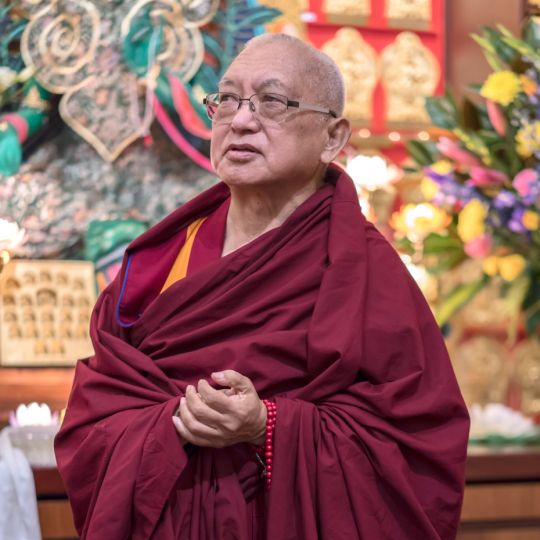
Lama Zopa Rinpoche at Chenerzig Institute, Eudlo, Australia, June 2018. Photo by Ven. Lobsang Sherab.
Lama Zopa Rinpoche offered this advice during a teaching at Chenrezig Institute in June 2018.
There are so many wars. Hundreds of thousands get killed again and again. So many people get killed by bombs. Then so many people escape, then the boat is full, then sinks in the ocean. They try to run away, they can’t do anything: it is unbelievable. The people in the world are suffering.
Syria is one example. It originated from one person not understanding that all came from his mind. Not understanding that the creator is one’s own mind. Can you imagine it? Millions and millions of people killed by the one person who has power, who did not realize this.
Your mind is the creator of everything, all the suffering and all the happiness. That person didn’t realize that, thinks all is coming from outside. So that is an unbelievably important education to help the world, to help to bring peace and happiness in the world.
So therefore we need Dharma centers giving teachings. Lamrim teachings, yes, but what it is all about is compassion. Teaching compassion, to practice compassion with sentient beings. With whom you practice compassion, with whom you generate compassion is sentient beings.
That is the essence of Buddhism, the Buddha’s teachings—to generate compassion not only to human beings, but to every single hell being, hungry ghost, animal, the tiniest and the big, like whales living in the ocean, the worms living under the earth, also the tiniest flies, which when you walk in the grass they run, jump away. There are numberless universes so there are numberless human beings, numberless sura beings, asura beings. Compassion to everyone—that is the essence of Buddhism. What differentiates it from others is that. To everyone, any sentient being, to have compassion, to never give them up, to have compassion for them.
Compassion means to not harm, and on top of that, if you can, to benefit. The motivation is compassion. If you want to practice Buddhism, you understand the conduct is to not harm sentient beings. And that comes from the right view, dependent arising, subtle dependent arising, which is unified with emptiness from its own side. The conduct comes from there—to not harm and to benefit sentient beings. That is often what His Holiness says. Now you can see that teaching Buddhism, through a course, or just talking about Buddhism to somebody, to explain compassion is the most important part.
Watch a clip of the teaching by Lama Zopa Rinpoche from which this advice is taken:
https://youtu.be/3V84cd4Cwcc?t=9m12s
A long time ago a million children were dying from no food in Africa—so much suffering, no rain coming, no water, drought. And even when the crops were there, suddenly a flood came and they were destroyed. So I thought to help. I thought first maybe to invite some lamas, some monks, to make it rain in Africa. I thought to invite them. Then I thought our students—here there are old students, Roger and Paula. I thought maybe to send them there to make it rain.
I translated lutor, Torma Offering to the Nagas, a long time ago. I didn’t translate it, I gave it to a Tibetan boy, a young man, to translate. He was a disciple of Tara Rinpoche. He translated it, and then I lost it. Then Paula found the translation in the Vajrapani Institute office. Then as it is advised there, she went to the mountains and did the puja to the nagas to make it rain. Then the rain did come, I heard that.
So I thought to send them to make rain. I also thought to invite lamas, monks there. I would sponsor them to make rain and then they would do puja to make it rain. But if the people don’t have good karma, it won’t work. If the people don’t have good karma, it won’t rain. To receive rain, it depends on having good karma. For everything, if it is happiness you have to have good karma. If you don’t have good karma, then you have to create good karma. Then you will achieve that happiness. You will experience it. You have to work through that.
People have to create good karma. So, how to do that? I was thinking about how to do that. I thought maybe I would go there, make friends with somebody in Africa. Talk about compassion to that person, so then that person is able to understand, then he can talk to his best friends about compassion, then they practice compassion. So little by little, three, four, five, then ten, like that, gradually, you talk about compassion, then they practice compassion, helping others. It doesn’t mean only people, but any sentient being. You practice compassion, to not harm and to help. So more and more people do that, and slowly it spreads, the positive actions, creating good karma. Then you make puja, a naga puja or whatever, then the rain will come.
You need to start like that. First you lead them in how to create good karma. You have to educate them to practice compassion. You need to do that a lot in the world. That is the most important thing, the most important education, the most important meditation to make the human being better, a better human being. To not become the cause of, to not become the creator of problems and suffering for yourself. You are human being this life, so don’t become a creator of problems in the world. To not become a creator of problems to all sentient beings, to the people in the world, to yourself, to your family, practice compassion. Then you become more and more a creator of happiness, peace, for you, your family, then your country, the world, all sentient beings. I thought like that but, sorry, I myself didn’t get to go there, to start like that.
So that’s what we need: teaching Buddhism, teaching Buddhadharma, establishing a center—a place where sentient beings can come to learn Dharma, to meditate, to purify and collect merits, to have realizations, a place where sentient beings open their minds, open their closed minds. The phenomena that they don’t see, to which they are closed, they become open to see all those phenomena—reincarnation and karma, all the rest of phenomena. Sentient beings are suffering—so therefore, what is needed is teaching Dharma, even to start a study group, no matter where you are living in the world, to study.
If you know some meditation, if you know lamrim, study it a little bit. Even just two or three people, to learn, to go through the lamrim, meditate and read and discuss is so important. So more people gain compassion. You aim for that. Not just learning to feed your intelligence, but to develop compassion. Your aim should be that: for you and also for other people to develop compassion. That is so good. It is so important. The more you learn compassion, then you give less harm to others, less harm and the more benefit to others. That is your source of achieving happiness up to enlightenment. It is the source of you achieving happiness up to enlightenment, for you and every sentient being; for you, and you cause that for every sentient being. Unbelievable.
You can see now you have to think in this way, of the proper motivation to have Dharma centers. Compassion is the most important. Even a Dharma study group, even one person, even one sentient being, to open the mind, to learn Dharma, to awaken the mind, to wake up the sleeping mind, the ignorant mind, even to help one person, one sentient being, even that is so important, unbelievably important. Teaching compassion, that brings them to enlightenment. That makes them have the opportunity to achieve enlightenment, the final goal. Wow wow wow.
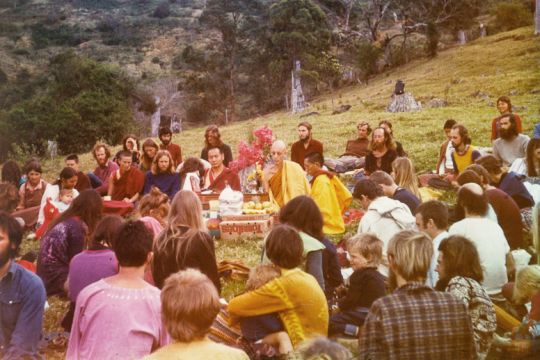
On the last day of the Diamond Valley course, Lama Yeshe and Lama Zopa Rinpoche, with their guest the English monk Phra Kantipalo, went with students to the land that would become Chenrezig Institute for an incense puja, Eudlo, Australia, September 1974. Photo courtesy Lama Yeshe Wisdom Archive.
For example, Chenrezig Institute has benefited numberless sentient beings since it started. Since the beginning of the course in Diamond Valley* and up to now, so many sentient beings have come to learn Dharma, have come to meditate, have come to purify the cause of suffering, and create the merits, the cause of all happiness up to enlightenment—coming to Chenrezig Institute to learn Dharma, the whole path to enlightenment.
Since the course in Diamond Valley up to now, so many sentient beings got benefit. They purified the cause of suffering, samsara and lower realms. It is amazing, amazing. So many practiced renunciation of the cause of suffering, renouncing attachment, renouncing anger, ignorance. So many, so many, so many practiced bodhichitta, even if they didn’t have the realization but did the meditation. So many created the cause to achieve nirvana, to be free, liberated from samsara. Sooooooooooooo many sentient beings starting from the Diamond Valley course up to now, so many created the cause to achieve nirvana, to be liberated from samsara.
So many sentient beings meditated on, thought about, bodhichitta. They generated bodhichitta, even if it was not the actual realization. Every time they generate bodhichitta, it becomes the cause of enlightenment. Each time they generate bodhichitta, the cause of enlightenment, they create the cause to bring enlightenment to numberless sentient beings. That includes their own families, the numberless sentient beings, numberless hell beings, numberless hungry ghosts, then numberless animals, numberless human beings, numberless asuras, numberless suras, numberless intermediate state beings, to bring enlightenment to them.
They created the cause of enlightenment from the Diamond Valley course up to now, wow wow wow. Just from Chenrezig Institute, so many.
Colophon: Excerpted from Lama Zopa Rinpoche’s teachings at Chenrezig Institute in Eudlo, Queensland, Australia, June 2, 2018. Simultaneously transcribed by Ven. Joan Nicell. Edited by Claire Isitt and Laura Miller, August 2018.
*The Diamond Valley course was the first Australian teaching event by Lama Yeshe and Lama Zopa Rinpoche. It took place August 30–September 28, 1974, in Diamond Valley, located not far the present-day Chenrezig Institute, in southeast Queensland, Australia.
Find complete videos of Lama Zopa Rinpoche’s recent teachings:
https://fpmt.org/media/streaming/teachings-of-lama-zopa-rinpoche/
Lama Zopa Rinpoche is the spiritual director of the Foundation for the Preservation of Mahayana Tradition (FPMT), a Tibetan Buddhist organization dedicated to the transmission of the Mahayana Buddhist tradition and values worldwide through teaching, meditation and community service.
- Tagged: advice from lama zopa rinpoche, chenrezig institute, essential extract, fpmt organization, lama zopa rinpoche, video
24
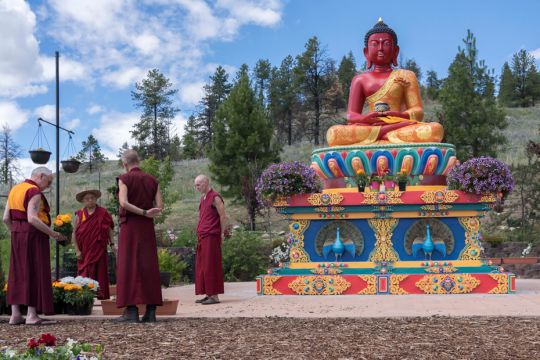
Lama Zopa Rinpoche and Sangha arranging flower offerings for the Amitabha Buddha statue, Buddha Amitabha Pure Land, Washington, US, July 2018. Photo by Ven. Lobsang Sherab.
Before traveling to India at the end of August and then Singapore in September, Lama Zopa Rinpoche spent nearly three months in the United States. Rinpoche stayed for two months at Buddha Amitabha Pure Land (BAPL) in a remote part of Washington State.
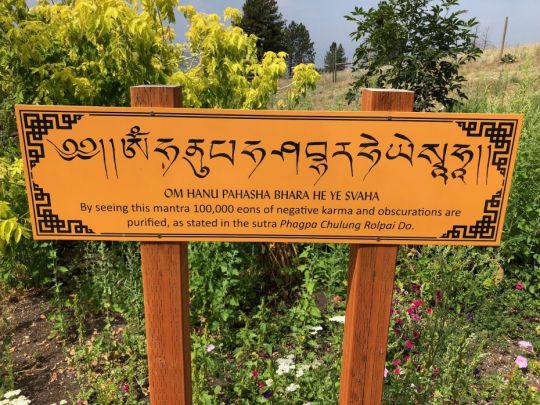
A Just By Seeing Mantra that Rinpoche had made into a sign at Buddha Amitabha Pure Land, August 2018. Photo by Ven. Roger Kunsang.
During Rinpoche’s time at BAPL, the decorations on the throne of the large Amitabha Buddha statue were completed. Rinpoche and Sangha made extensive flower offerings. Rinpoche also had many signs made for animal statues on the land.
While in Washington State, Rinpoche visited Pamtingpa Center, in Tonasket, Washington. Rinpoche and Sangha also took a boat out onto a lake to bless all the sentient beings in the water.
In August, Rinpoche visited Maitripa College and FPMT International Office in Portland, Oregon, for a week. Then Rinpoche spent a week in Boston, Massachusetts, giving teachings and initiations at Kurukulla Center.
Rinpoche then flew to California for a brief visit to his home, Kachoe Dechen Ling, in Aptos, and for annual medical checkups.
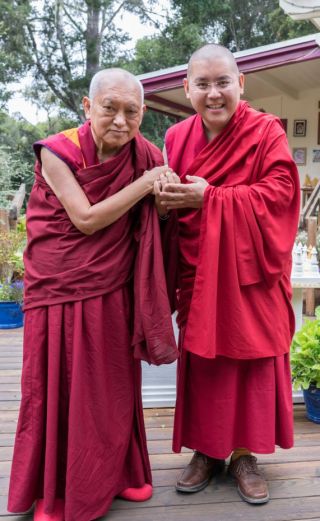
Lama Zopa Rinpoche and H.E. Ling Rinpoche, Kachoe Dechen Ling, Aptos, California, US, August 2018. Photo by Ven. Lobsang Sherab.
While in Aptos, Rinpoche invited H.E. Ling Rinpoche, who was on a West Coast tour, to stay one night at Kachoe Dechen Ling. Lama Zopa Rinpoche gave H.E. Ling Rinpoche a tour of the holy objects and showed H.E. Ling Rinpoche the collection of precious relics there. Dinner was offered to H.E. Ling Rinpoche and after dinner both Rinpoches did protector prayers together.
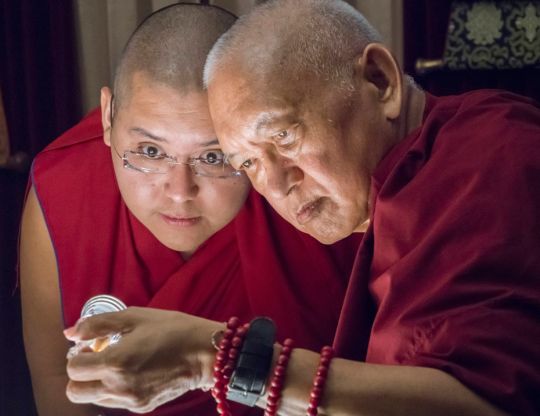
H.E. Ling Rinpoche and Lama Zopa Rinpoche looking at a relic, Kachoe Dechen Ling, Aptos, California, US, August 2018. Photo by Ven. Lobsang Sherab.
On another day, Rinpoche invited Geshe Ngawang Dakpa, the resident geshe at Tse Chen Ling in San Francisco, for lunch. Rinpoche also visited the nearby Land of Medicine Buddha to check on the progress of the stupa being built. More than fifty students saw Rinpoche off at the airport for his flight to India.
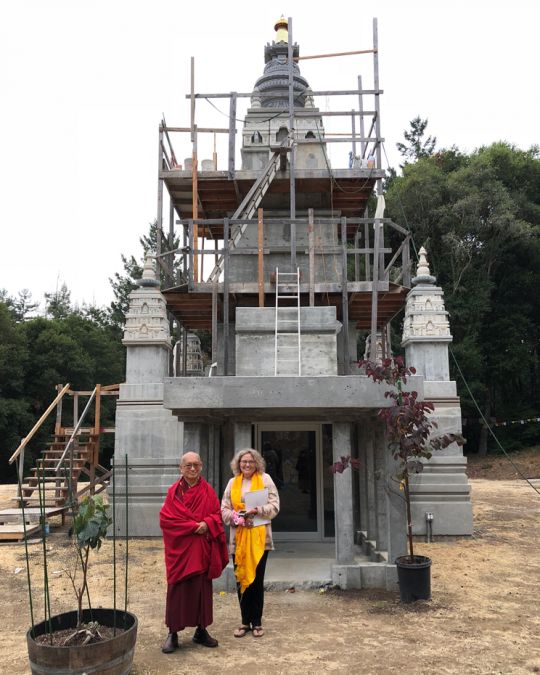
Rinpoche and Denice Macy, former director of Land of Medicine Buddha, in front of stupa being built at Land of Medicine Buddha, Soquel, California, US, August 2018. Photo by Ven. Roger Kunsang.
See a NEW photo album with more photos from Lama Zopa Rinpoche’s three months in the United States:
https://fpmt.org/teachers/zopa/gallery/united-states-june-august-2018/
Links and information to watch Lama Zopa Rinpoche teach live:
https://fpmt.org/media/streaming/lama-zopa-rinpoche-live/
Watch recorded video teachings from Lama Zopa Rinpoche, including recent teachings at Amitabha Buddhist Centre, Kurukulla Center, and Maitripa College:
https://fpmt.org/media/streaming/teachings-of-lama-zopa-rinpoche/
More information, photos, teaching schedule, and updates about FPMT spiritual director Lama Zopa Rinpoche can be found on Rinpoche’s webpage on FPMT.org. If you’d like to receive news of Lama Zopa Rinpoche and FPMT via email, sign up to FPMT News.
- Home
- News/Media
- Study & Practice
- About FPMT Education Services
- Latest News
- Programs
- New to Buddhism?
- Buddhist Mind Science: Activating Your Potential
- Heart Advice for Death and Dying
- Discovering Buddhism
- Living in the Path
- Exploring Buddhism
- FPMT Basic Program
- FPMT Masters Program
- FPMT In-Depth Meditation Training
- Maitripa College
- Lotsawa Rinchen Zangpo Translator Program
- Universal Education for Compassion & Wisdom
- Online Learning Center
- Prayers & Practice Materials
- Overview of Prayers & Practices
- Full Catalogue of Prayers & Practice Materials
- Explore Popular Topics
- Benefiting Animals
- Chenrezig Resources
- Death & Dying Resources
- Lama Chopa (Guru Puja)
- Lama Zopa Rinpoche: Compendium of Precious Instructions
- Lama Zopa Rinpoche: Life Practice Advice
- Lama Zopa Rinpoche Practice Series
- Lamrim Resources
- Mantras
- Prayer Book Updates
- Purification Practices
- Sutras
- Thought Transformation (Lojong)
- Audio Materials
- Dharma Dates – Tibetan Calendar
- Translation Services
- Publishing Services
- Teachings and Advice
- Find Teachings and Advice
- Lama Zopa Rinpoche Advice Page
- Lama Zopa Rinpoche: Compendium of Precious Instructions
- Lama Zopa Rinpoche Video Teachings
- ༧སྐྱབས་རྗེ་བཟོད་པ་རིན་པོ་ཆེ་མཆོག་ནས་སྩལ་བའི་བཀའ་སློབ་བརྙན་འཕྲིན།
- Podcasts
- Lama Yeshe Wisdom Archive
- Buddhism FAQ
- Dharma for Young People
- Resources on Holy Objects
- Ways to Offer Support
- Centers
- Affiliates Area
- Teachers
- Projects
- Charitable Projects
- Make a Donation
- Applying for Grants
- News about Projects
- Other Projects within FPMT
- Support International Office
- Projects Photo Galleries
- Give Where Most Needed
- FPMT
- Shop
Translate*
*powered by Google TranslateTranslation of pages on fpmt.org is performed by Google Translate, a third party service which FPMT has no control over. The service provides automated computer translations that are only an approximation of the websites' original content. The translations should not be considered exact and only used as a rough guide.The root of your life’s problems becomes non-existent when you cherish others.







